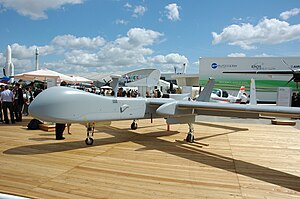EADS Harfang
| Harfang | |
|---|---|
 |
|
| Role | Remote controlled, medium altitude, long endurance drone |
| Manufacturer | EADS and IAI |
| First flight | 9 September 2006 at Istres-Le Tubé airbase 125 |
| Introduction | June 2008 |
| Primary user | French Air Force |
| Number built | 4 |
| Developed from | IAI Heron |
The EADS Harfang, formerly known as Système intérimaire de drone MALE (SIDM, "Interim medium-altitude, long-endurance drone system") is a drone system used by the French Air Force, supplementing the RQ-5 Hunter.
The French Air Force purchased its first drones in 1995, with a number of RQ-5 Hunter. The IAI Heron was put on display at the 1999 Paris Air Show and generated some interest; a project to field a derivative was started two years later. On 9 September 2006, a prototype was launched for trials from Istres-Le Tubé Air Base. Trials by the Centre d'essais en vol followed, before transfer of the plane to Mont-de-Marsan Air Base
The drone was originally planned to be delivered to the Air Force for the summer of 2003 as a replacement for the Hunters, which were phased out in September 2004. A number of industrial setbacks delayed the delivery, notably that the satellite communication system did not conform with Air Force requirements. The drones were modified to satisfy the requirements, changing them from an "off-the-shelf" product into a custom plane built specially for the French Air Force. The plane and onboard computer are built by Malat, a division of Israel Aerospace Industries, based on the IAI Heron.
The French Air Force ordered three planes and two ground control stations. The SIDM entered service in June 2008 in the Drone Experimentation Squadron 1/330 Adour, in Cognac, a unit of the Centre des expérimentations militaires. A four-phase programme took place between 2008 and 2009:
The Harfang is composed of two main components: the drone and the ground control station.
The Harfang drone is an unmanned airplane propelled by a rear-mounted turbo-supercharged water-cooled flat-four engine, driving a pusher propeller. It features a flapped high wing with anti-icing system, and has a twin boom tail with two vertical surfaces. With a take-off mass of 1.2 tonnes, the Harfang can carry a 250-kg payload to height of 7500 metres for a duration of 24 hours.
...
Wikipedia
